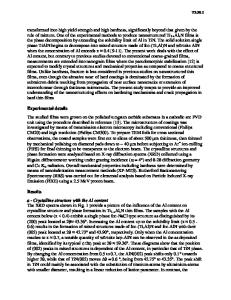Effect of Hydrogen on Thermal Stress in Layered Structure of Ti and Ti(Al) Thin Films.
- PDF / 879,257 Bytes
- 6 Pages / 420.48 x 639 pts Page_size
- 12 Downloads / 336 Views
EFFECT OF HYDROGEN ON THERMAL STRESS IN LAYERED STRUCTURE OF Ti AND Ti(A1) THIN FILMS. C.-K. Hu, P.S. Ho, and D. Gupta, IBM Research Division, Thomas J. Watson Research Center, Yorktown Heights, N.Y. 10598. S.T. Chen, IBM General Technology Division, Hopewell Junction, N.Y. 12533
ABSTRACT The effect of hydrogen on stress in thin film structures has been investigated for Ti, Al, Ti(Al) and Al(Ti) films. The stress in the metal films was measured in-situ as a function of temperature and ambient (vacuum of 10- 6Torr., forming gas and nitrogen) using a The metal films were deposited on fused quartz or bending beam technique. polyimide/fused quartz substrates using a dual e-gun evaporation method. The stress in pure Ti films was found to be strongly dependent on the annealing environment. Upon thermal cycling in a forming gas, an abrupt change of stress in the Ti film due to crack formation and delamination in the Ti film was observed. The possibility to eliminate the hydrogen effect by Al addition has been investigated. The hydrogen effect can be reduced by an addition of 5 at.% Al, but stress induced crack formation similar to the pure Ti film was still observed in this alloy film. An increase to 20 at.% Al in the alloy films eliminated the hydrogen effect, however, such an alloy film was brittle as cracks and delamination were observed after one thermal cycle from room temperature to 350 'C. A similar behavior in stress relaxation was observed in an Al-riched film with 20 at. % Ti.
INTRODUCTION Thin film of Ti and its alloys are commonly used in VLSI metallizations for interconnection and packaging applications. The Ti film was used as a diffusion barrier layer, for a reduction of interfacial contact resistance, and as an adhesion layer to the dielectric materials. During VLSI processing, thin film metallization often undergoes thermal cycling and annealing in different ambients which can cause reliability problems due to the mechanical failures. Consequently, understanding of the stress relaxation behavior in thin films under processing conditions is important. For this purpose, we have used in-situ measurements to study stress as a function of film thickness, temperature, and ambient (vacuum, forming gas and nitrogen). We have previously reported the temperature dependence of stresses in metallic thin films(Ti, Cr, Cu) [1,2], polymeric films [3], and metal/polyimide [4] on fused quartz substrates annealed in nitrogen and vacuum. We report here an investigation of the effect of hydrogen on thermal stress in the Ti, Al, and Ti-Al alloy films. The exposure to hydrogen comes from annealing in forming gas (90% nitrogen and 10% hydrogen) which is often used in VLSI process steps to reduce metal oxidation. Annealing in forming gas brought marked changes in the mechanical behavior of Ti films, in particular, crack formation and delamination were observed. The possibility of eliminating the hydrogen effect by alloying with Al was investigated. The results will also be reported.
Mat. Res. Soc, Symp. Proc. Vol. 130. c 1989
Data Loading...










